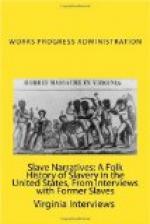“My name is James V. Deane, son of John and Jane Deane, born at Goose Bay in Charles County, May 20, 1850. My mother was the daughter of Vincent Harrison, I do not know about my father’s people. I have two sisters both of whom are living, Sarah and Elizabeth Ford.
“I was born in a log cabin, a typical Charles County log cabin, at Goose Bay on the Potomac River. The plantation on which I was born fronted more than three miles on the river. The cabin had two rooms, one up and one down, very large with two windows, one in each room. There were no porches, over the door was a wide board to keep the rain and snow from beating over the top of the door, with a large log chimney on the outside, plastered between the logs, in which was a fireplace with an open grate to cook on and to put logs on the fire to heat.
“We slept on a home-made bedstead, on which was a straw mattress and upon that was a feather mattress, on which we used quilts made by my mother to cover.
“As a slave I worked on the farm with other small boys thinning corn, watching watermelon patches and later I worked in wheat and tobacco fields. The slaves never had nor earned any cash money.
“Our food was very plain, such as fat hog meat, fish and vegetables raised on the farm and corn bread made up with salt and water.
“Yes, I have hunted o’possums, and coons. The last time I went coon hunting, we treed something. It fell out of the tree, everybody took to their heels, white and colored, the white men outran the colored hunter, leading the gang. I never went hunting afterwards.
“My choice food was fish and crabs cooked in all styles by mother. You have asked about gardens, yes, some slaves had small garden patches which they worked by moonlight.
“As for clothes, we all wore home-made clothes, the material woven on the looms in the clothes house. In the winter we had woolen clothes and in summer our clothes were made from cast-off clothes and Kentucky jeans. Our shoes were brogans with brass tips. On Sunday we fed the stock, after which we did what we wanted.
“I have seen many slave weddings, the master holding a broom handle, the groom jumping over it as a part of the wedding ceremony. When a slave married someone from another plantation, the master of the wife owned all the children. For the wedding the groom wore ordinary clothes, sometimes you could not tell the original outfit for the patches, and sometimes Kentucky jeans. The bride’s trousseau, she would wear the cast-off clothes of the mistress, or, at other times the clothes made by other slaves.
“It was said our plantation contained 10,000 acres. We had a large number of slaves, I do not know the number. Our work was hard, from sunup to sundown. The slaves were not whipped.
“There was only one slave ever sold from the plantation, she was my aunt. The mistress slapped her one day, she struck her back. She was sold and taken south. We never saw or heard of her afterwards.




